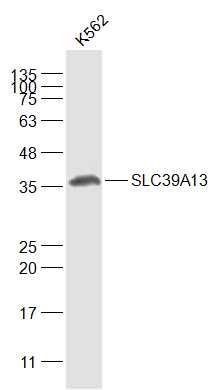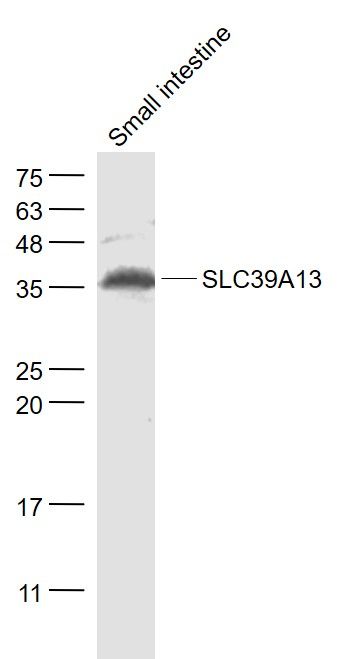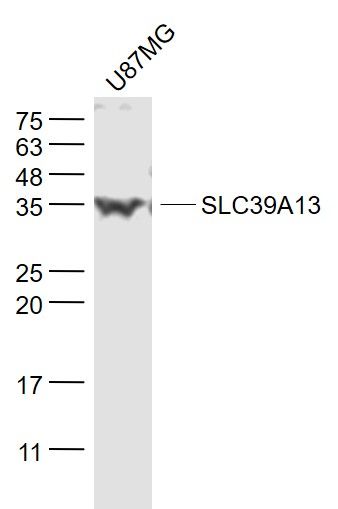SLC39A13 Polyclonal Antibody
Purified Rabbit Polyclonal Antibody (Pab)
- SPECIFICATION
- CITATIONS
- PROTOCOLS
- BACKGROUND

Application
| WB, IHC-P, IHC-F, IF, ICC, E |
|---|---|
| Primary Accession | Q96H72 |
| Reactivity | Rat |
| Host | Rabbit |
| Clonality | Polyclonal |
| Calculated MW | 39 KDa |
| Physical State | Liquid |
| Immunogen | KLH conjugated synthetic peptide derived from human SLC39A13 |
| Epitope Specificity | 1-100/371 |
| Isotype | IgG |
| Purity | affinity purified by Protein A |
| Buffer | Preservative: 0.02% Proclin300, Constituents: 1% BSA, 0.01M PBS, pH7.4. |
| SUBCELLULAR LOCATION | Membrane. |
| SIMILARITY | Belongs to the ZIP transporter (TC 2.A.5) family. |
| DISEASE | Defects in SLC39A13 are the cause of Ehlers-Danlos syndrome-like spondylocheirodysplasia (SCD-EDS) [MIM:612350]. SCD-EDS is a 'spondylocheiro dysplastic form of Ehlers-Danlos syndrome'. The syndrome consists of a generalized skeletal dysplasia involving mainly the spine (spondylo) and striking clinical abnormalities of the hands (cheiro) in addition to the EDS-like features. Clinical features included postnatal growth retardation, moderate short stature, protuberant eyes with bluish sclerae, hands with finely wrinkled palms, atrophy of the thenar muscles, and tapering fingers. Patients have thin, hyperelastic skin and hypermobile small joints consistent with an Ehlers-Danlos-like phenotype. Radiologic features included mild to moderate platyspondyly, mild to moderate osteopenia of the spine, small ileum, flat proximal femoral epiphyses, short, wide femoral necks, and broad metaphyses (elbows, knees, wrists, and interphalangeal joints). |
| Important Note | This product as supplied is intended for research use only, not for use in human, therapeutic or diagnostic applications. |
| Background Descriptions | This gene encodes a member of the LIV-1 subfamily of the ZIP transporter family. The encoded transmembrane protein functions as a zinc transporter. Mutations in this gene have been associated with the spondylocheiro dysplastic form of Ehlers-Danlos syndrome.[provided by RefSeq, Mar 2010] |
| Gene ID | 91252 |
|---|---|
| Other Names | Zinc transporter ZIP13, LIV-1 subfamily of ZIP zinc transporter 9, LZT-Hs9, Solute carrier family 39 member 13, Zrt- and Irt-like protein 13, ZIP-13, SLC39A13, ZIP13 |
| Dilution | WB=1:500-2000,IHC-P=1:100-500,IHC-F=1:100-500,ICC=1:100-500,IF=1:100-500,ELISA=1:5000-10000 |
| Format | 0.01M TBS(pH7.4), 0.09% (W/V) sodium azide and 50% Glyce |
| Storage | Store at -20 ℃ for one year. Avoid repeated freeze/thaw cycles. When reconstituted in sterile pH 7.4 0.01M PBS or diluent of antibody the antibody is stable for at least two weeks at 2-4 ℃. |
| Name | SLC39A13 (HGNC:20859) |
|---|---|
| Synonyms | ZIP13 |
| Function | Functions as a zinc transporter transporting Zn(2+) from the Golgi apparatus to the cytosol and thus influences the zinc level at least in areas of the cytosol (PubMed:21917916, PubMed:23213233). May regulate beige adipocyte differentiation (By similarity). |
| Cellular Location | Golgi apparatus membrane; Multi-pass membrane protein. Cytoplasmic vesicle membrane. Endoplasmic reticulum membrane |

Thousands of laboratories across the world have published research that depended on the performance of antibodies from Abcepta to advance their research. Check out links to articles that cite our products in major peer-reviewed journals, organized by research category.
info@abcepta.com, and receive a free "I Love Antibodies" mug.
Provided below are standard protocols that you may find useful for product applications.
If you have used an Abcepta product and would like to share how it has performed, please click on the "Submit Review" button and provide the requested information. Our staff will examine and post your review and contact you if needed.
If you have any additional inquiries please email technical services at tech@abcepta.com.













 Foundational characteristics of cancer include proliferation, angiogenesis, migration, evasion of apoptosis, and cellular immortality. Find key markers for these cellular processes and antibodies to detect them.
Foundational characteristics of cancer include proliferation, angiogenesis, migration, evasion of apoptosis, and cellular immortality. Find key markers for these cellular processes and antibodies to detect them. The SUMOplot™ Analysis Program predicts and scores sumoylation sites in your protein. SUMOylation is a post-translational modification involved in various cellular processes, such as nuclear-cytosolic transport, transcriptional regulation, apoptosis, protein stability, response to stress, and progression through the cell cycle.
The SUMOplot™ Analysis Program predicts and scores sumoylation sites in your protein. SUMOylation is a post-translational modification involved in various cellular processes, such as nuclear-cytosolic transport, transcriptional regulation, apoptosis, protein stability, response to stress, and progression through the cell cycle. The Autophagy Receptor Motif Plotter predicts and scores autophagy receptor binding sites in your protein. Identifying proteins connected to this pathway is critical to understanding the role of autophagy in physiological as well as pathological processes such as development, differentiation, neurodegenerative diseases, stress, infection, and cancer.
The Autophagy Receptor Motif Plotter predicts and scores autophagy receptor binding sites in your protein. Identifying proteins connected to this pathway is critical to understanding the role of autophagy in physiological as well as pathological processes such as development, differentiation, neurodegenerative diseases, stress, infection, and cancer.




